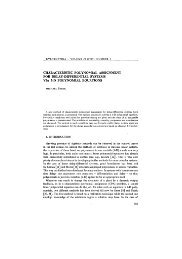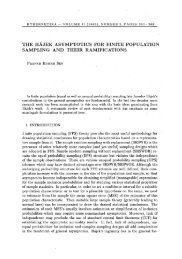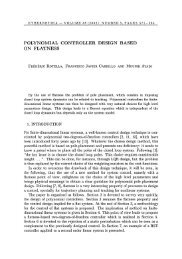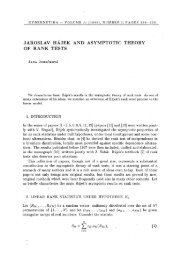tuning the zhu-takaoka string matching algorithm and ... - Kybernetika
tuning the zhu-takaoka string matching algorithm and ... - Kybernetika
tuning the zhu-takaoka string matching algorithm and ... - Kybernetika
You also want an ePaper? Increase the reach of your titles
YUMPU automatically turns print PDFs into web optimized ePapers that Google loves.
Tuning <strong>the</strong> Zhu-Takaoka String Matching Algorithm <strong>and</strong> Experimental Results 69<br />
that matched <strong>and</strong> do not compare <strong>the</strong>m again with <strong>the</strong> text. The TBM <strong>algorithm</strong><br />
<strong>and</strong> <strong>the</strong> Apostolico-Giancarlo <strong>algorithm</strong> perform in <strong>the</strong> worst case at most 2n <strong>and</strong><br />
1.5n character comparisons respectively.<br />
The Horspool (HOR) <strong>algorithm</strong> [10] is a simplification of <strong>the</strong> BM <strong>algorithm</strong>.<br />
It does not use <strong>the</strong> good suffix function, but uses a modified version of <strong>the</strong> last<br />
occurrence function. The modified last occurrence function determines <strong>the</strong> right<br />
most occurrence of <strong>the</strong> (k + m)th text character, T[k + m] in <strong>the</strong> pattern, if a<br />
mismatch occurs when a pattern is aligned with T[k...k + m]. The comparison<br />
order is not described in [10]. We assumed that <strong>the</strong> order is from right to left as in<br />
<strong>the</strong> BM <strong>algorithm</strong>.<br />
The Raita (RAI) <strong>algorithm</strong> [15] uses variables to represent <strong>the</strong> first, middle <strong>and</strong><br />
last characters of <strong>the</strong> pattern. The process used is to compare <strong>the</strong> rightmost character<br />
of <strong>the</strong> pattern, <strong>the</strong>n <strong>the</strong> leftmost character, <strong>the</strong>n <strong>the</strong> middle character <strong>and</strong><br />
<strong>the</strong>n <strong>the</strong> rest of <strong>the</strong> characters from <strong>the</strong> second to <strong>the</strong> (m — l)th position. Using<br />
variables is more efficient than looking up <strong>the</strong> characters in <strong>the</strong> pattern array. The<br />
use of variables to represent characters in <strong>the</strong> array is known as 'Raita's trick'. This<br />
optimization trick is only used in <strong>the</strong> RAI <strong>algorithm</strong>. If at any time during <strong>the</strong><br />
procedure a mismatch occurs <strong>the</strong>n it performs <strong>the</strong> shift as in <strong>the</strong> HOR <strong>algorithm</strong>.<br />
The Quicksearch (QS) <strong>algorithm</strong> [18] is similar to <strong>the</strong> HOR <strong>algorithm</strong> <strong>and</strong> <strong>the</strong><br />
RAI <strong>algorithm</strong>. It does not use <strong>the</strong> good suffix function to compute <strong>the</strong> shifts. It uses<br />
a modified version of <strong>the</strong> last occurrence function. Assume that a pattern is aligned<br />
with <strong>the</strong> text characters T[k ... k + m]. After a mismatch <strong>the</strong> length of <strong>the</strong> shift is<br />
at least one. So, <strong>the</strong> character at <strong>the</strong> next position in <strong>the</strong> text after <strong>the</strong> alignment<br />
(T[k + m + 1]) is necessarily involved in <strong>the</strong> next attempt. The last occurrence<br />
function determines <strong>the</strong> right most occurrence of T[k + m + 1] in <strong>the</strong> pattern. If<br />
T[A: + m + 1] is not in <strong>the</strong> pattern <strong>the</strong> pattern can be shifted by m + 1 positions.<br />
The comparisons between text <strong>and</strong> pattern characters during each attempt can be<br />
done in any order.<br />
The Maximal Shift (MS) <strong>algorithm</strong> [18] is ano<strong>the</strong>r variant of <strong>the</strong> QS <strong>algorithm</strong>.<br />
The <strong>algorithm</strong> is designed in such a way that <strong>the</strong> pattern characters are compared<br />
in <strong>the</strong> order which will give <strong>the</strong> maximum shift if a mismatch occurs.<br />
The Liu, Du <strong>and</strong> Ishi (LDI) <strong>algorithm</strong> [13] is a variant of <strong>the</strong> QS <strong>algorithm</strong>. The<br />
<strong>algorithm</strong> uses <strong>the</strong> same shifting function as <strong>the</strong> QS but changes <strong>the</strong> order in which<br />
<strong>the</strong> pattern characters are compared to <strong>the</strong> text. The characters are compared in<br />
a circular method starting at <strong>the</strong> first character in <strong>the</strong> pattern <strong>and</strong> finishing at <strong>the</strong><br />
last. If a mismatch occurs <strong>the</strong>n <strong>the</strong> pattern is shifted <strong>and</strong> searching restarts with<br />
<strong>the</strong> pattern character that mismatched. For example, if <strong>the</strong> pattern was '<strong>string</strong>'<br />
<strong>and</strong> <strong>the</strong> pattern mismatched <strong>the</strong> text at <strong>the</strong> V <strong>the</strong>n we would search in <strong>the</strong> order<br />
( ringst\<br />
The Smith (SMI) <strong>algorithm</strong> [16] uses HOR <strong>and</strong> Quick Search last occurrence<br />
functions. When a mismatch occurs, it takes <strong>the</strong> maximum values between <strong>the</strong>se<br />
functions. The characters are compared from left to right.<br />
The Zhu <strong>and</strong> Takaoka (ZT) <strong>algorithm</strong> [20] is ano<strong>the</strong>r variant of <strong>the</strong> BM <strong>algorithm</strong>.<br />
The comparisons are done in <strong>the</strong> same way as BM (i. e. from right to left) <strong>and</strong> it uses<br />
<strong>the</strong> good suffix function. If a mismatch occurs at T[i], <strong>the</strong> last occurrence function






